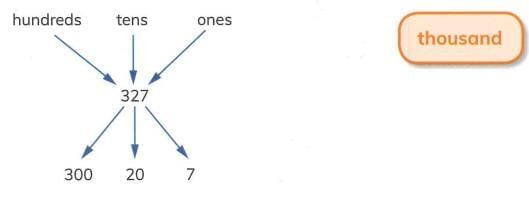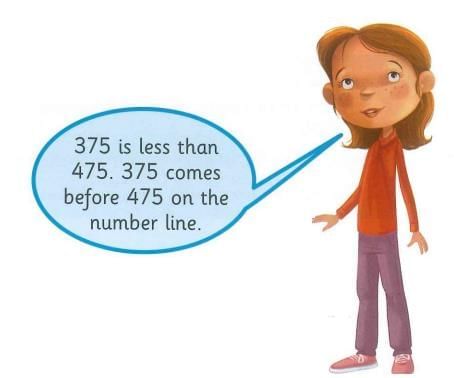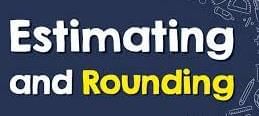Class 3 Exam > Class 3 Notes > Year 3 Mathematics IGCSE (Cambridge) > Chapter Notes: Numbers to 1000
Numbers to 1000 Chapter Notes | Year 3 Mathematics IGCSE (Cambridge) - Class 3 PDF Download
| Table of contents |

|
| Introduction |

|
| Hundreds, tens and ones |

|
| Comparing and ordering |

|
| Estimating and rounding |

|
Introduction
This chapter helps us to understand numbers up to 1000. We learn how to read and write numbers, understand place value of digits, compare and order numbers, and round them to the nearest tens or hundreds. These skills are important in daily life, such as reading page numbers in a book, house numbers, or counting days in a year.Hundreds, tens and ones
- We learn to say, read and write numbers and number words from 0 to 1000.
- Understand the value of each digit in a 3-digit number (hundreds, tens, ones).
- Be able to count forward and backward in steps of 1 and 10 from any number.
3-digit numbers are made from hundreds, tens and ones.
Example: 327 = 300 + 20 + 7.

It is important to know what each digit represents to understand the full value of the number.
Example: 472 → The digit 7 is in the tens place. Its value is 70. Saying numbers out loud helps to understand the value of each digit.
Tomas makes nine 3-digit numbers using place value cards. Examples of numbers: 473, 689, 358, 134, 925, 247, 791. We need to find two more possible numbers. Different answers are possible, but we should explain our choices and compare with others.
I can say, read and write numbers and number words from 0 to 1000. I know the value of each digit in a 3-digit number. I can count on and count back in steps of 1 and 10 from any number.
Comparing and ordering
We learn to compare numbers by checking the value of each digit.
Use inequality symbols:
- “<” means less than.
- “>” means greater than.
Order numbers from smallest to greatest and greatest to smallest.
Place numbers correctly on a number line and estimate their positions.

Use numbers and symbols (<, >, =) to make correct statements. Example: 234, 243, 278 can be arranged with symbols in different correct ways. Compare answers with others and check if they are same or different. Work together to find all possible solutions.
- I can compare numbers by looking at digit values.
- I can use inequality symbols (< and >) when comparing numbers.
- I can order numbers from smallest to greatest and greatest to smallest.
Estimating and rounding
- We learn to estimate quantities by giving a range of numbers.
- Round numbers to the nearest 10.
- Round numbers to the nearest 100.
- Estimation helps when the exact number is not required. A sensible guess is enough.

Estimation can be done by:
- Looking at groups of objects and giving a range.
- Rounding numbers to the nearest 10 or 100.
The document Numbers to 1000 Chapter Notes | Year 3 Mathematics IGCSE (Cambridge) - Class 3 is a part of the Class 3 Course Year 3 Mathematics IGCSE (Cambridge).
All you need of Class 3 at this link: Class 3
|
65 docs|19 tests
|
FAQs on Numbers to 1000 Chapter Notes - Year 3 Mathematics IGCSE (Cambridge) - Class 3
| 1. What are hundreds, tens, and ones in numbers, and how do they relate to understanding numbers up to 1000? |  |
Ans. Hundreds, tens, and ones are the basic place values used in the decimal number system. In a number, the hundreds place represents how many groups of 100 are present, the tens place shows how many groups of 10 are present, and the ones place indicates the single units. For example, in the number 472, there are 4 hundreds, 7 tens, and 2 ones. This system helps in understanding and organizing numbers, making it easier to perform operations like addition and subtraction.
| 2. How do you compare and order numbers up to 1000? |  |
Ans. To compare and order numbers up to 1000, you can look at the highest place value first, which is the hundreds place. If two numbers have the same hundreds digit, you then compare the tens place. If those are also the same, you compare the ones place. For instance, to order the numbers 432, 321, and 456, you would first compare the hundreds: 4 (in 432 and 456) is greater than 3 (in 321), so 321 is the smallest. Then, between 432 and 456, since 4 is the same, you compare tens: 3 (in 432) is less than 5 (in 456), making the order 321, 432, 456.
| 3. What is estimating and rounding, and how can it be applied to numbers up to 1000? |  |
Ans. Estimating involves finding a close approximation of a number, while rounding is the process of adjusting a number to make it simpler, often to the nearest ten, hundred, or other specified place value. For example, when rounding 467 to the nearest hundred, it becomes 500, since 467 is closer to 500 than to 400. Rounding helps simplify calculations and makes it easier to work with large numbers, especially in estimation for practical applications like budgeting or measuring.
| 4. Can you give examples of how to round numbers to the nearest ten and hundred? |  |
Ans. Yes! To round a number to the nearest ten, you look at the ones digit. If it is 5 or more, you round up. For example, 43 rounds to 40, while 47 rounds to 50. To round to the nearest hundred, you look at the tens digit. If it is 5 or more, you round up. For instance, 236 rounds to 240, and 264 rounds to 300. These techniques help simplify numbers for easier calculation.
| 5. Why is it important to learn about numbers up to 1000 in Grade 3? |  |
Ans. Learning about numbers up to 1000 in Grade 3 is important because it lays the foundation for basic arithmetic skills, including addition, subtraction, and understanding place value. Mastery of these concepts enhances problem-solving abilities and prepares students for more complex mathematical concepts in higher grades. It also encourages logical thinking and helps students make sense of the world around them through numerical understanding.
Related Searches














